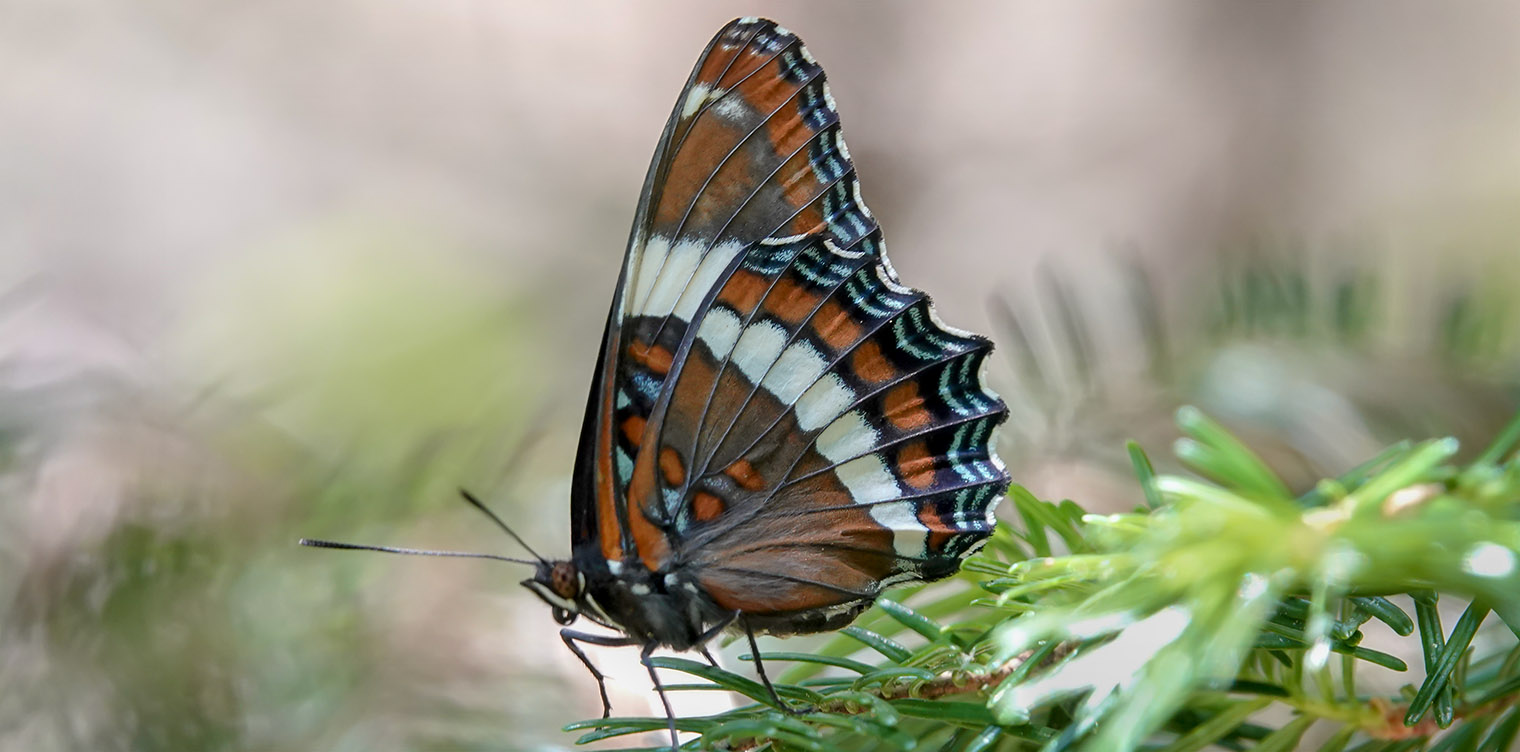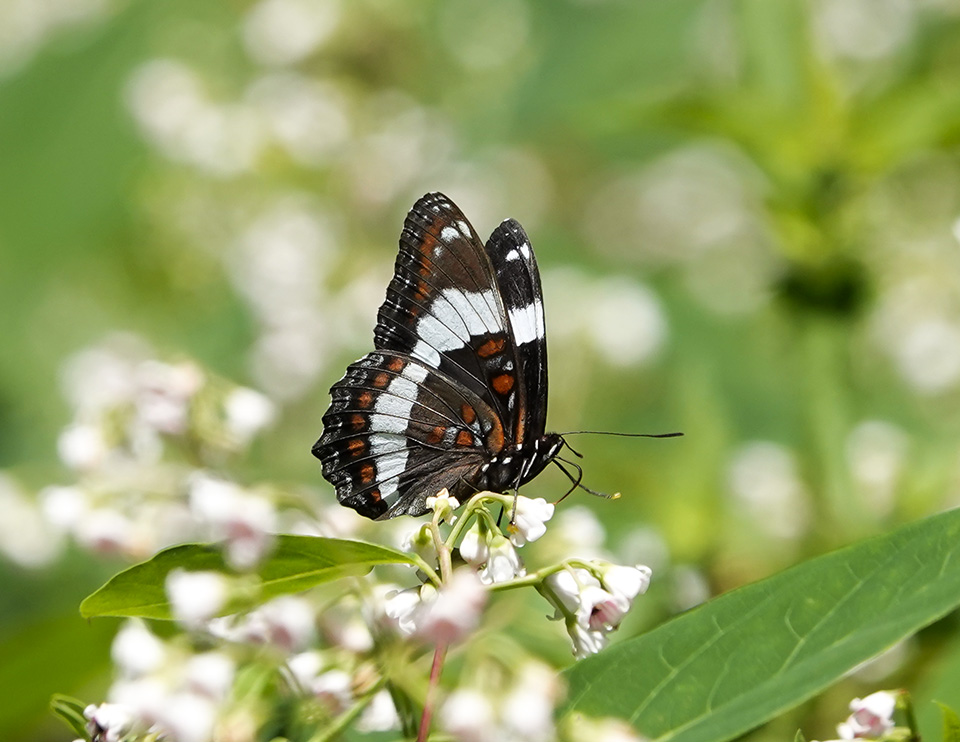Butterflies of the Adirondacks:
White Admiral (Limenitis arthemis)

The White Admiral (Limenitis arthemis arthemis) is a medium to large black and white butterfly that may be seen in the Adirondack Mountains of upstate New York in summer. It is a member of the Brushfoot family of butterflies. [1]
The name Admiral is said to have originated in England, when a white-banded butterfly came to be known as a white "admirable" because of its beauty. This name was later applied to its North American relatives. [2] The genus name (Limenitis) derives from the Latin word limen, which means threshold. Arthemis refers to a goddess in Greek mythology, the sister of Apollo. [3]
White Admiral: Identification

White Admirals are fairly easy to identify. The colors to look for are black and white.
- From above, the White Admiral has a broad white band crossing a black ground color on both wings. [4] On the hind wing, there is a row of blue spots with red dots. [5]
- From below, the White Admiral sports a row of white bands on both wings, with brick red spots near the edge and some blue markings near the body.[6] [7]
- The average wingspan of this butterfly is about 3 inches. [8]
White Admiral: Life History
The eggs are grayish-green. [9] Host plants include willow, aspen, poplar, and birch. [10] Caterpillars reportedly feed mostly at night. [11] Adults consume sap, nectar, decaying organic matter, and scat, as well as moisture from damp sand. [12] [13]
White Admiral: Habitat and Range

The White Admiral is widespread and common in mixed and deciduous forests, forest edges, and near streams. [14] [15] Typical habitats of the White Admiral also include roads and clearings in wooded areas. These butterflies reportedly enjoy sunning themselves on leaves and gravel roads. [16]
There are several subspecies of Limenitis arthemis. Here in the Adirondacks, our White Admiral is in the subspecies arthemis, which is found in the northeastern part of the US and the southeastern parts of Canada. [17] [18]
White Admiral: Flight
Sightings reported on iNaturalist and Butterflies and Moths of North America suggest that White Admirals (Limenitis arthemis arthemis) are usually present in New York State from around early June through late August into early September. In the New York City area, they were reported to fly from mid-May to mid-July, but were most common in early to mid June. [19]
The White Admiral's flight period in the Adirondack Park has not been established. However, sighting records suggest that this butterfly flies in our region from mid- to late June and early July through early August into September.
- In 2012, the White Admiral was seen in the Paul Smith's College VIC Native Species Butterfly House in mid- and late June. [20]
- In 2013, it was seen in the Adirondack region in early July. [21]
- In 2014, the White Admiral was seen in the Adirondacks in late June and early July. [22]
- In 2015, the White Admiral was reported in the Adirondack region from mid-June through mid-July. [23] [24]
- In 2016, the White Admiral only a few sightings were reported for the Adirondack region, in June and July. [25] [26]
- In 2017, the White Admiral was reported in the Adirondacks from mid-June through late-July. [27] [28]
- In 2018, confirmed sightings reports for the White Admiral increased significantly. It is unclear whether this was the result of increased public willingness to report sightings, a real increase in the abundance of this butterfly in the summer of 2018, or a combination of both. Sightings were from early-June through mid-September, with clusters of sightings throughout July. [29] [30]
References
- Susan Grimm Hanley. Interpretive Naturalist, Paul Smith's College Native Species Butterfly House. Species Logbooks.
- Butterflies and Moths of North America. Species Profiles. Sighting records: 7/21/2011; 6/16/2012; 6/23/2012; 6/28/2012; 6/30/2012, 6/22/2013; 7/6/2013; 7/12/2013; 7/12/2013; 6/12/2014; 6/19/2014; 6/19/2014; 6/19/2014; 6/19/2014; 6/22/2014; 6/22/2014; 7/13/2014; 6/25/2015; 8/7/2015; 6/21/2016; 6/25/2016; 7/20/2017; 6/2/2018; 6/20/2018; 6/26/2018; 6/30/2018; 7/8/2018; 7/8/2018; 7/9/2018; 7/11/2018; 7/11/2018; 7/11/2018; 7/11/2018; 7/15/2018; 7/15/2018; 8/19/2018. Retrieved 20 February 2019.
- iNaturalist. Adirondack Park Sightings. White Admiral. Retrieved 20 February 2019.
- Government of Canada. Canadian Biodiversity Information Facility. SpeciesBank. White Admiral. Retrieved 20 February 2019.
- Massachusetts Butterfly Club. Massachusetts Butterfly Species List. Red-spotted Admiral. Limenitis arthemis. Retrieved 20 February 2019.
- Iowa State University. Department of Entomology. BugGuide. Limenitis arthemis. Retrieved 20 February 2019.
- University of Michigan. Animal Diversity Web. Limenitis arthemis. Retrieved 20 February 2019.
- Ross A. Layberry, Peter W. Hall, and J. Donald Lafontaine. The Butterflies of Canada (University of Toronto Press, 1998), pp. 208-209, Plates 17 and 27.
- National Audubon Society. Field Guide to Butterflies (New York: Alfred A. Knopf, 1981), pp. 635-636.
- Jim P. Brock and Kenn Kaufman. Kaufman Field Guide to Butterflies of North America (Houghton Mifflin, 2003), pp. 210-211.
- Paul A. Opler. A Field Guide to Eastern Butterflies (The Peterson Field Guide Series, Houghton Mifflin Company, 1992,1998), pp. 90-91, 278-279.
- Jeffrey Glassberg. Butterflies of North America (Michael Friedman Publishing, 2002), pp. 158.
- James A. Scott. The Butterflies of North America. A Natural History and Field Guide (Stanford University Press, 1986), pp. 260-261.
- Donald and Lillian Stokes. Stokes Butterfly Book. The Complete Guide to Butterfly Gardening, Identification, and Behavior (Little, Brown and Company, 1991), pp. 80-83.
- Jeffrey Glassberg. Butterflies through Binoculars. The East. A Field Guide to the Butterflies of Eastern North America (Oxford University Press, 1999), p. 127, Plate 38.
- Paul A. Opler and George O. Krizek. Butterflies East of the Great Plains: An Illustrated Natural History (The Johns Hopkins University Press, 1984), pp. 166-167, Plate 31.
- Rick Cech and Guy Tudor. Butterflies of the East Coast. An Observer's Guide (Princeton University Press, 2005), p. 196.
